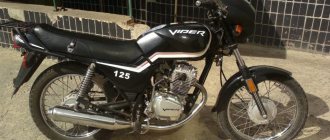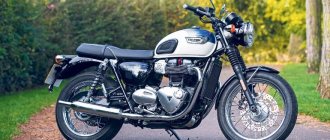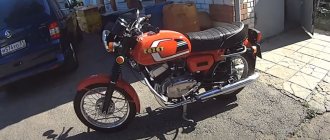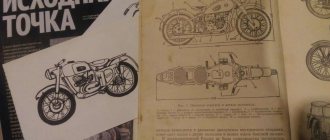IZh escort motorcycles with rotary engines (20 photos)
Author: zaMKADpride
January 22, 2016 08:11
Tags: USSR and motorcycle motorcycle
56628
20
At the end of the 80s, an experimental model of an escort (to accompany convoys of official delegations and patrol service) motorcycle with RPD was created. Specialists from the Izhevsk Motor Plant were entrusted with this project, and this was a full-fledged government order, which provided for the model to be put into small-scale production.
0
See all photos in the gallery
Bogatyrev Viktor Nikolaevich and Glukhov German Yakovlevich are working on the IZH-Lider model:
0
The power unit provided for the installation of a 2-section rotary piston engine RD-601. With a working volume of 613 cubic meters, it produced 52 hp. at 6000 rpm and maximum torque of 51Nm (at 3500 rpm). This installation was developed in Togliatti and was largely unified with VAZ rotary units, which at that time had already begun to be actively installed on cars for special services. The final version of the IZH-Lider motorcycle with RPD:
×
0
As a result of the design search, several running models of the “Soviet superbike” were born, which in their appearance resembled the best examples of the then Japanese and German motorcycles.
0
The first was the IZh Leader, a vehicle with a very developed hood and massive plastic fairings that well protected the driver from wind and precipitation. With its contours, it somehow reminds me of the legendary BMW K1 sports tourer, which was born around the same time (1988). This is the condition the unique motorcycle was in the last time it was seen:
0
As on the Bavarian, the engine’s thrust was transmitted to the rear wheel via a cardan. Two experimental versions of the Leader were built: the first with the already mentioned RPD, and the second with the more familiar 2-cylinder opposed internal combustion engine from the serial Ural motorcycle. And these are the remains of another Leader - with a motor from the Urals:
0
Another escort motorcycle from Izhmash was named IZH-8.201 or “Vega”. He had a more graceful and swift appearance. Unlike the “Leader,” his appearance did not evoke associations with medieval knights.
0
In search of the optimal shape... The prototypes were built around both a chassis with a RPD and a conventional boxer engine.
0
The design practically corresponded to the best Western models, although some elements looked alien on such a handsome car: for example, drum brakes or spoked wheels (although the project also included alloy wheels). The final version of an escort motorcycle with a rotary piston engine:
0
Modern and attractive design:
0
Option with a classic internal combustion engine:
0
In addition to the rotary Vega, there was also a more down-to-earth version of this escort, in the chassis of which a 650 cc boxer engine from the Dnepr motorcycle was installed. No worse than the then BMW, Honda and Moto Guzzi:
0
Reverse gear is cardan.
0
Drum brakes are not the topic here:
0
The plans of the creators were ambitious: to establish a full-fledged serial production of such devices and even organize mass deliveries abroad - for the needs of police services in different countries. A perfectly preserved example of IZH-8.201 at one of the modern exhibitions:
0
It's a pity that he never made it onto the production line.
0
2-section rotary piston engine RD-601 with a power of 52 hp:
0
However, perestroika, related problems in the USSR economy and the further collapse of the country put an end to these promising developments.
0
The power unit was built by AvtoVAZ specialists.
0
There are also spoked wheels.
0
The instrument panel is partially unified with the Zhiguli.
Source:
Related links:
- The most unusual motorcycles
- Brand new motorcycle IZH Jupiter-3 1976 in original packaging
- The era of motor scooters in the USSR
- Legendary motorcycles of the USSR
- Legendary motorcycles of the USSR
Tags: USSR and motorcycle motorcycle
Do you like to remember how things were before? Join us, let's feel nostalgic together:
395 5 390
Liked
390 5
75
Partner news
IZhik in the fog
Although motorcycles of various modifications and characteristics were created in Soviet times, several were certainly the most common. And in the village, for a long time, it remained almost the only mode of transport. The girls used it for rides, went fishing, hauled hay and firewood—whenever they weren’t using it.
Meanwhile, few people know that the pedigree of IZH began at the beginning of the last century, when a young engineer of noble roots, Pyotr Mozharov, arrived after studying at the University of Leipzig. The director of the Izhmash Museum, Alexey Azovsky, talks about the history of the creation of Izhevsk motorcycles.
Alexey Alekseevich, who was Pyotr Mozharov and what was his fate?
Alexey Azovsky
: Heating engineer by training, he was already passionate about motorsports, he had his own imported motorcycle, on which he “cut” around Izhevsk.
In the city, Mozharov modernized steam boilers, even designed snowmobiles and gliders, but all this time he was haunted by the dream of his own, not imported, Soviet motorcycle. And in 1929, together with a group of similar enthusiasts, he released the first experimental series of IZH motorcycles. The first three IZHs - from the first to the third modification - were heavy. The fourth and fifth are easy. In September 1929, this entire convoy of vehicles, with the participation of several more foreign cars, set off for the first Soviet motorcycle rally, Izhevsk - Nizhny Novgorod - Moscow - Leningrad - Kharkov.
The main result of the motorcycle rally was that the design of the motorcycles turned out to be so successful that the convoy covered the entire multi-thousand-mile journey with virtually no breakdowns. It would seem that the motorcycle could be put into production, but this was not done. A large construction project was underway in the country, different opinions about priorities clashed in the Supreme Council of National Economy (VSNKh), and the need to create a motorcycle plant in Izhevsk could not be proven.
Nevertheless, it was Izhevsk that later became the “capital” of Soviet motorcycles?
Azov
: After that unsuccessful attempt, Mozharov went first to Leningrad, where he designed a light motorcycle, and then to Moscow, where he created a heavy one. But then he returns to Izhevsk again, where he produces five experimental motorcycles and takes them to be shown in the capital. This time, the country's leadership gave the go-ahead, and motorcycles are starting to be mass-produced at the Podolsk Machine-Building Plant. In total, 4.5 thousand pieces were made before the war. Although this is a drop in the ocean for such a huge country, they can still be found in museums and private collections.
And yet, Mozharov saw Izhevsk as the city where the mass production of motor vehicles should be organized. Here, at the newly created motorcycle plant, the production of truly mass-produced Soviet motorcycles “IZH-6” and “IZH-7” was launched.
As soon as the first motorcycles left the factory assembly line, Mozharov took a vacation for the first time in his life, which became fatal for him. In March 1934, a telegram arrived at the plant saying: Mozharov died under unclear circumstances. Either he committed suicide, or someone “helped” him die. In 2012, his grave was found only by chance by local residents. They became interested in the inscription on a fragment of a gravestone, which stated that the creator of the first Soviet motorcycles was buried here.
Did the plant also produce motorcycles during the war?
Azov
: No, with the beginning of the war the motor plant switched to producing Maxim machine guns, but after the war the company returned to IZHs. Although not quite related to IZham. In 1946, a small motorcycle was almost entirely exported from near Dresden to Izhevsk, which actually predetermined the fate of further Izhevsk motorcycles, and indeed all Soviet motorcycles, given the scale of production in Izhevsk. And, according to some, not for the better. The fact is that a German motorcycle with a 350 cc engine was taken as the basis. see. After the war, this parameter was forgotten almost throughout the world, with the exception of several countries of the socialist camp. And the world is flooded with 500 cc motorcycles and “multiples” of them with engine capacity from 125 to 1000 cc. And if, for example, they had sent to Izhevsk, which already then specialized in the production of 500 cc cars, it is still unknown what the fate of the domestic motorcycle industry would have been. But history, as we know, does not tolerate the subjunctive mood, and the Izhevsk plant began to produce motorcycles with an engine capacity of 350 cubic meters.
To start producing motorcycles, a group of German engineers was brought to the plant. This is how the first post-war Izhevsk motorcycle was created - the famous IZH-49, which was almost a copy of the DKW-350. They changed the front suspension on it - they installed a telescopic fork, installed a second saddle, new shock absorbers, and made a number of other minor changes. Perhaps precisely because they did not interfere much with the design of the German car, the IZH-49 turned out to be reliable and was produced in large volumes until 1956. Then the Izh-56 appeared with dashboard panels, a higher number of revolutions and engine power.
In the 1970s, it and its modifications were replaced by the famous Planet family, the most popular Soviet motorcycle. The two-cylinder Jupiter, which later tried to replace it, turned out to be less reliable and did not gain such popularity.
Does the plant still produce motorcycles now?
Azov
: Unfortunately no. On April 1, 2008, production of IZH was discontinued. Over the entire period, 10,770 thousand motorcycles rolled off the factory assembly line. It’s hard to say why it all ended this way. This is still being debated. Personally, I believe that, despite the apparent abundance of brands, for decades the plant produced essentially the same thing. It was a time of general shortage, when it was possible to buy a motorcycle only on lists or on occasion. Then why spend money on re-equipping the plant, why fight for engine efficiency when gasoline costs 20 kopecks? They’ll take the motorcycle anyway, in any quantity, and they’ll even say thank you.
Case in point. In 1970, for the next party congress, the plant management was given an order from Moscow to make a new motorcycle - a gift to the Soviet people. But the money for its creation was given only 5% of what was needed. And so our factory designers begin to do their best to ensure that the motorcycle is “like new” and to meet the budget. They move the turn signal to the headlight, order a new gas tank and master painting the motorcycle in two colors. A number of other minor changes are being made. But in principle it is still the same motorcycle. As a result, the party’s task is completed, and the Soviet person receives a “gift”. And it will take another 10 years to produce the “old-new” motorcycle. 55 years have passed since the German motorcycle was brought to Izhevsk, and although, of course, hundreds of changes have been made to its design, its “ears” still stick out. The entire basic layout and ideology of the machine remained the same.
And when the borders were opened in the 90s and people had the opportunity to compare cars, the demand for domestic motorcycles fell sharply. At the same time, prices for materials and energy resources increased, and production costs increased sharply. And when these two factors came together in time, the Soviet motorcycle industry actually became a thing of the past.
Couldn’t the famous “IZH Planet-Sport” become the very “straw” that a drowning man grabs?
Azov
: There was actually an interesting story with him. In the early 70s, an initiative group was created at the plant, which developed a truly new, promising model with the possibility of export deliveries. The characteristics were quite at the level of the Yamas and Hondas of that time. They made one prototype and sent it to VDNKh. And “Sport” had not only good characteristics, but also an impressive appearance. Foreigners saw him at the exhibition, and they began to think: “We’ll take 30 thousand, 40 thousand.” The director of the plant was summoned to the Central Committee of the CPSU and told: if you decided to put up a motorcycle without asking, please organize production in the required quantities for export within a year. And at the factory there is only a prototype.
Two ready-made new buildings intended for the production of weapons were immediately converted to produce motorcycles. Naturally, everything was done in a hurry. And there was neither time nor money to fine-tune the design. As a result, the motorcycle in the series turned out to be completely different from what was intended, and it did not go abroad. In the USSR, of course, they were chasing him, but the plan for the plant was based on the total number of motorcycles produced, without taking into account models. But its labor intensity is many times higher, and “Sports” was made only a small part of the total number.
The end result was that the ministry said: make your “Planet” better. Later they began to establish cooperation with the Japanese, they tried to produce scooters, but these were already difficult years, and everything remained at the level of prototypes...











